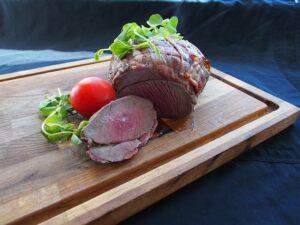Hungarian venison is a popular export item
While few people know it at home, Hungarian venison is a sought-after product abroad. About 3,800 tons of processed venison are produced annually by domestic processors, almost 90 percent of which is purchased by export partners. Hungarian consumers rarely come across game meat, even though it should be included in our diet as often as possible due to its special taste and its effect on health. The National Chamber of Agrarian Economy has collected information about the game meat market in a publication.

(Photo: Pixabay)
Our country has a high-quality, diverse game population thanks to its unique environmental features in Europe. The most common big game are roe deer, red deer, wild boar, fallow deer and mouflon. Among the small game, hares and pheasants are the most significant. In recent decades, the number of big game has increased continuously, according to the publication prepared by the National Chamber of Agrarian Economy, which presents the current events and market prospects of the domestic game meat market, and also gives an idea of domestic game meat consumption habits.
The topic was scrutinized with the help of market analysis
Hungarian game meat market opportunities and game consumption habits, named in Hungary, according to a market analysis that is also unique in European terms, in 2021, those entitled to hunt sold almost 11,000 tons of shot game to processors, in terms of our five most important big game, of which approximately 3,800 tons of meat products were produced in our country. In Hungary, 46 enterprises are currently engaged in game meat processing, and in most places farmed and shot game are also included in the plant. The largest share of the supply is made up of frozen goods, while the demand for pre-chilled (usually vacuum-packed) products is limited to the main season – from September to December. The smaller players supply the market with very high-quality, highly processed products, various pâtés, rillettes, sausages, and smoked goods come out of the processors. In addition, products from family farms, wildlife parks, and national park products also appear on the market, which are primarily available locally.
Hungarian venison is a sought-after product on the European market
We export up to 90 percent of all processed game meat – about 3,500 tons. Our most important customer market is Germany, where 48 percent of Hungarian venison goes, but we also export a significant amount to Italy. Although the Covid epidemic also battered the game meat market, demand increased again with the end of the closures. In 2022, the market found itself perceptibly, and our venison exports exceeded the pre-pandemic level in both quantity and value. About 40 percent of the quantity remaining on the Hungarian market is sold to retailers, and 60 percent is purchased by the HORECA sector through wholesalers. Domestic consumption is still at a very low level: the average Hungarian consumes only 10 dekagrams of venison a year, which is a significant drop even compared to the 20 dekagram level in 2010. Although venison does not only provide consumers with a special taste experience, it also has many beneficial properties from a physiological point of view. During its life, the wild animal is raised freely in natural conditions, leads a lifestyle rich in movement, feeds in a variety of ways, and its consumption and emissions are part of the natural cycle in every detail. In terms of healthy nutrition, game meat has a lower energy content and a more favorable protein, fat and microelement content compared to farmed domestic animals. Game meat has many quality characteristics that can be attractive to health-conscious consumers when purchasing meat products.
NAK
Related news
More than 100 Hungarian farmers also demonstrated in Brussels
🎧 Hallgasd a cikket: Lejátszás Szünet Folytatás Leállítás Nyelv: Auto…
Read more >Hungarian champagne crowns the end-of-year holidays!
🎧 Hallgasd a cikket: Lejátszás Szünet Folytatás Leállítás Nyelv: Auto…
Read more >NAK: Domestic producers await customers with an ample supply of all pine species
🎧 Hallgasd a cikket: Lejátszás Szünet Folytatás Leállítás Nyelv: Auto…
Read more >Related news
Christmas shock in commerce: for the first time, we can pay with bank cards in fewer places
🎧 Hallgasd a cikket: Lejátszás Szünet Folytatás Leállítás Nyelv: Auto…
Read more >Hungarian Confectionery Manufacturers Association: trends in 2025 and prospects for 2026
🎧 Hallgasd a cikket: Lejátszás Szünet Folytatás Leállítás Nyelv: Auto…
Read more >Most grocery chains will be open until noon on December 24th
🎧 Hallgasd a cikket: Lejátszás Szünet Folytatás Leállítás Nyelv: Auto…
Read more >






